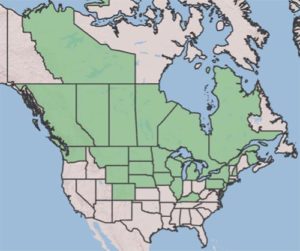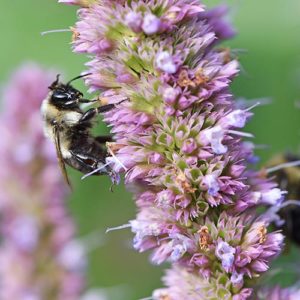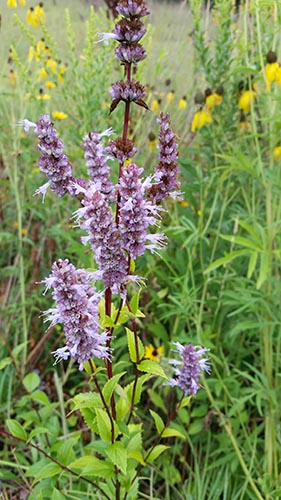Introduction
Anise hyssop (Agastache foeniculum) is a perennial native wildflower for parts of the northern half of the U.S. and into Canada. Some resources, such as the USDA Plants Database, consider it native to Kentucky. Other resources consider it adventive (likely escaped from cultivation) in Kentucky. No resources have it listed as native anywhere south of Kentucky; however, it can be grown as an ornamental wildflower or culinary herb outside of its native range. Other common names for anise hyssop include blue giant hyssop and lavender hyssop.

Biology and Life History
Anise hyssop is a member of the mint family. It commonly grows to 3-4 feet tall, but can get as tall as 5 feet. In the wild, anise hyssop is most often found in dry, open areas such as prairies and barrens. Each summer, this perennial wildflower will produce spiked clusters of lavender to purple flowers. The flowers will continue to bloom for several months.
Pollinator and Wildlife Uses
Like many other members of the mint family, anise hyssop is a bee magnet. The flowers are highly attractive to honey bees and many of our native bees such as bumble bees, mining bees, leaf cutter bees, and sweat bees. Butterflies, moths, and hummingbirds will also frequently visit the flowers. After the flowers go to seed, songbirds will eat the seeds. Deer and rabbits will mostly avoid anise hyssop.

Human Uses
Anise hyssop has a long history of culinary and medicinal uses. The leaves, flowers, and seeds are all edible. In 2019, the International Herb Association named it the Herb of the Year. The leaves have a licorice-like scent when they are crushed and are often dried for herbal teas. The flowers are sometimes sprinkled on salads and the seeds can be used in baked goods. The flower stalks can also be used in either fresh or dried flower arrangements. (Dried flowers tend to keep their color.)
Incorporating Anise Hyssop into Your Yard
Anise hyssop has become a popular garden plant and plant for larger pollinator plantings. In garden settings, it can be grown, even outside of its native range, in most of Zones 4-8. Anise hyssop prefers full sun, but can take partial shade. It can also grow in a wide variety of soils, but doesn’t really like soggy soils. Trimming it in the early spring will promote bushiness and the production of more flower stalks. Deadheading the flowerheads when they start to fade can also encourage new blooms and prolong the bloom time.
When planting anise hyssop in a garden setting, remember that it is in the mint family. It will spread by both seed and by underground rhizomes or runners, so you might want to give it a little room. However, it doesn’t tend to spread near as much as what most of us think of when someone says “mint.” Like with other mints, deer and rabbits tend to avoid eating it.

Because of its popularity, many native plant nurseries carry anise hyssop within its native range. In addition to the straight species, several cultivars have been developed and can be found throughout the horticulture trade. However, some sources suggest that not all of the cultivars are as attractive to pollinators as the straight species. I haven’t found any scientific research on that topic, but it might be worth keeping in mind if attracting pollinators is your primary reason for growing anise hyssop.
Summary
Anise hyssop provides abundant nectar and pollen for bees and nectar for other pollinators during the summer months. It can make a great addition to pollinator gardens when it is allowed a little room to spread. In its native range, it can also be a valuable addition to larger pollinator plantings. In addition to its benefits for pollinators and wildlife, anise hyssop has a long history of being used by people.

Backyard Ecology: Exploring Nature in Your Backyard
Nature isn’t just “out there.” It’s all around us, including right outside our doors. Hi, my name is Shannon Trimboli, and I am the host of Backyard Ecology. I live in southcentral Kentucky and am a wildlife biologist, educator, author, beekeeper, and owner of a nursery specializing in plants for pollinators and wildlife conservation. I invite you to join me as we ignite our curiosity and natural wonder, explore our yards and communities, and improve our local pollinator and wildlife habitat. Learn more or subscribe to my email list at www.backyardecology.net.

Leave a Reply